Barcelona is the Catalan capital with millions of inhabitants and a magnificent location on the warm Mediterranean coast. Today, Barcelona is in Spain, but the Catalan history, language and culture clearly make the city and region different to the rest of Spain, and this is interesting to see as a visitor.
Over time, amazing buildings have been built in the various neighborhoods, of which Barri Gotic is the old medieval center with cozy streets, distinguished squares and churches and palaces from ancient times, where rulers of the city were in power. The old town feeling is enjoyed among other places on the beautiful Plaça del Rei and at the cathedral.
Eixample is the district where you will find many of the famous works of modernism, which for many visitors is the main reason for a trip to the city. When you say Barcelona and modernism, you automatically think of the world famous architect Antonio Gaudí. Barcelona was his city and his designs are seen in many places in the city. His masterpieces include La Sagrada Familia, Casa Mila and Park Güell.
Barcelona also opens up to the water, and here is the port worth seeing as well as a walk to the neighborhood of Barceloneta. The many tour boats offer interesting harbor cruises, and in Barceloneta you can both eat delicious seafood and take a dip in the Mediterranean almost in the middle of the Catalan capital.
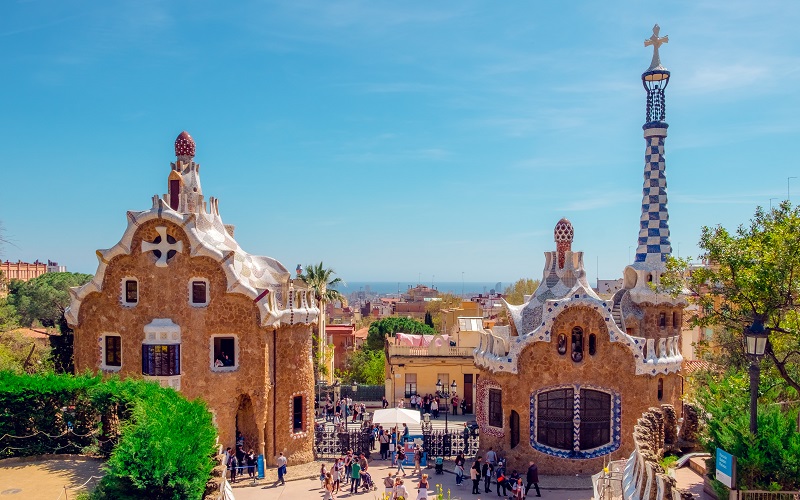
Park Güell is a 17-hectare park that was designed by Antoni Gaudí and laid out 1900-1914. The park was originally intended as a place for wealthy residences by the founder Eusebi Güell, after whom the park was also named. Güell was inspired by the English garden city movement, and the new quarter was located on the hillsides of El Carmel at a good distance from the city’s factories.
However, the plans were not realised in the scale that was intended. Only two out of sixty planned houses were built. The houses were not designed by Gaudí, who was however persuaded by Güell to move in here in one of the houses. It was in Torre Rosa, which is now known as the museum of Casa Museu Gaudí. Instead of the unbuilt houses, today you can enjoy a lovely park, which is one of Barcelona’s most famous places.
Antoni Gaudí was responsible for the design of the park, which emphasizes the artist’s original style within Catalan modernism. The central element of the park is the large terrace, where you can see the well-known bench shaped like a serpent, the fountain of El Drac and the curved colonnade. The paths in the park are also part of the experience, and from the top of the hill there is a great view of Barcelona.
Park Güell is today inscribed on UNESCO’s World Heritage List, along with other of Antoni Gaudí’s works. The special thing about Park Güell is that Gaudí was given quite a free hand over a large area to shape his designs in the characteristic organic style he also used for eg the Sagrada Familia. The result can be enjoyed already from the entrance to the park and in all places of the area.
Plaça del Rei is a square that forms the architectural center of Barcelona’s old quarter, and this is clearly visible when you arrive here on a stroll through the city. Medieval Gothic buildings surround the square with the former royal palace at the forefront. The palace’s tower, Torre Mirador del Rei Martí, stands like a real skyscraper from the 16th century.
There is much to see around the square despite its limited size. You can, for example, visit the City History Museum/Museu d’Historia de la Ciutat, which depicts Barcelona’s history from Roman times to the present day. The museum is housed in Casa Clariana-Padellas, a Gothic trading house built in the 16th century, and in the basement you can see archaeological excavations of the former Roman city.
At Plaça del Rei you can also see the Palau Reial Major, Catalonia’s former royal palace. The earliest of the construction dates back to the 13th century, although the site itself was also the administrative center of the city back to the time of the Roman Empire. The central room of the palace is the Saló del Tinell. It is a particularly beautiful banquet hall from 1362 and one of the highlights of the palace.
The Saint Agatha Royal Chapel/Capilla Reial de Santa Àgueda stands as a part of the Palau Reial Major complex. The chapel was built as the palace’s church in Gothic style in the 14th century during the reign of Jaume II. The construction took place on the foundations of an older Romanesque chapel, which had again been built on top of the old city walls.
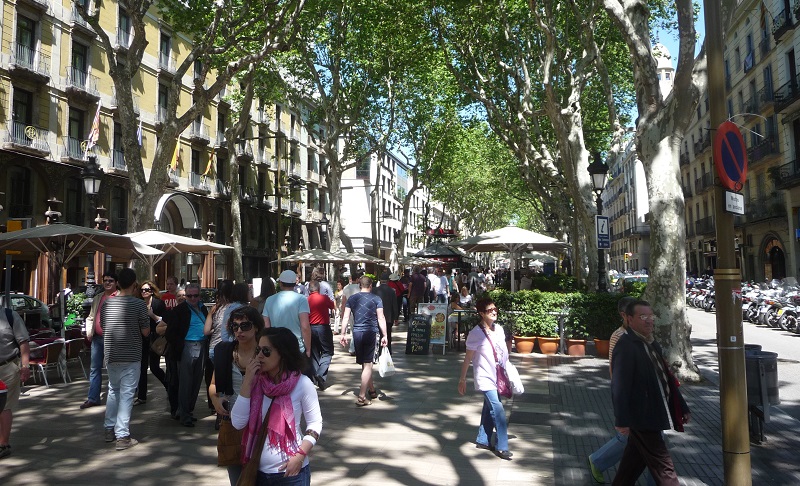
La Rambla is Barcelona’s beautiful and world-famous pedestrian street, where all visitors to the city should take a stroll and feel the city. On the 1.2 kilometer long Rambla there are shady trees, flower markets, artists, shops, restaurants, many interesting buildings and an always pleasant atmosphere. La Rambla connects Plaça de Catalunya to the north with the city’s port area to the southeast.
In the northern part of the street, next to number 133, you can see the famous Canaletes Fountain/Font de Canaletes. The fountain is shaped with a lamppost on top, and it is said that after one sip you will come back to Barcelona. It’s hard to say whether it has anything to do with it, but after a walk along La Rambla, you definitely want to come back to the city another time.
If you continue south, you will pass the Teatre Poliorama and the Bethlehem Church/Església de Betlem, which is one of Barcelona’s few Baroque buildings. The church was originally part of a Jesuit monastery when it was built in 1553. However, it burned to the ground in 1936 during the Spanish Civil War and was subsequently rebuilt on the outside, while the interior of the church was not recreated as in the 16th century church.
From La Rambla there is also access to the beautiful Mercat de la Boqueria, which is a large market behind a number of house facades along La Rambla. Keep walking and as part of the pavement, you can enjoy the Mosaic de Joan Miró, which the artist created in 1976. Close to this is the Gran Teatre del Liceu, Barcelona’s impressive opera house, built in the mid-1800s.
Catedral is the local name for Barcelona’s imposing cathedral, formally the Cathedral of the Holy Cross and Saint Eulàlia/Catedral de la Santa Creu in Santa Eulàlia. There was already a basilica on this site from the year 343, but it was destroyed when the Moors conquered the area in the 10th century. A new cathedral was built in the middle of the 11th century, but this was demolished at the end of the 13th century, after which the current church was built.
The construction of the Catedral started in 1298, and after a long construction period interrupted by plague epidemics and peasant revolts, the cathedral was consecrated in 1459. At that time, however, the large building was not yet finished, as there were no funds for the planned facade. It took until the 19th century before the construction could be completed, and in 1889 the impressive facade was finished. It was built according to the original plans.
The cathedral stands as one of the masterpieces of Catalan Gothic architecture, and there is a richness of details to look at both externally and internally. Among the most noteworthy are the high altar, the bell tower from the 15th century and the crypt, where Saint Eulàlia, one of Barcelona’s two guardian angels, is buried. The dimensions of the cathedral are significant with a length of 93 meters and a height of the nave of 40 meters with 54 meter high bell towers. There are three naves and 28 side chapels in the interior of the great cathedral.
Casa Battló is one of Antoni Gaudí’s famous houses and creations, several of which are located in different locations in Barcelona. The house was originally built in 1877 by another architect and then completely rebuilt by Gaudí in the years 1905-1907. Like other of his buildings, the house is almost alive in its form of expression.
In the design, which is Gaudí’s special form of art nouveau, there are almost no straight lines, which you can clearly see on a visit here. A large part of the facade is decorated with broken ceramic tiles in different colours, which give the surface a characteristic appearance.
The interesting houses Casa Lleo Morera (remodeled 1906) and Casa Amattler (remodeled 1896) are located next to Casa Battló. The three houses are collectively called Block of Discord, because they are so different in expression, but lie right next to each other. The trilogy, led by Casa Battló, is one of the city’s best-known ensembles.
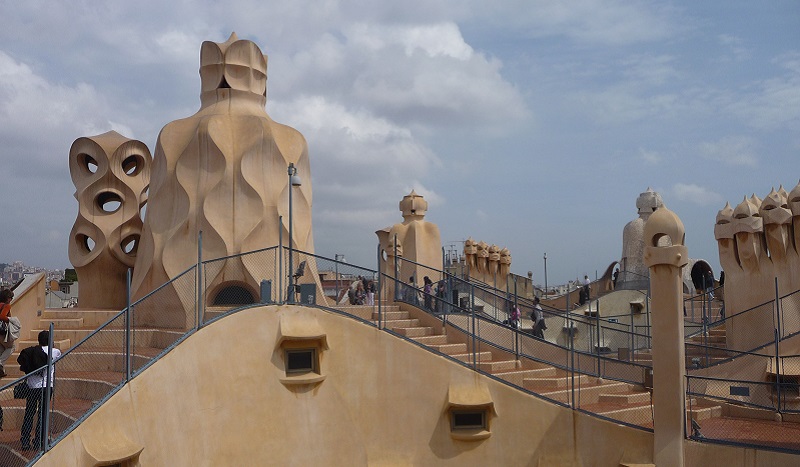
Casa Milà is a house that stands as one of Antoni Gaudí’s most famous buildings. It was built 1905-1907, and the most characteristic feature of this particular Gaudí creation is the house’s undulating facade, which has inspired other houses around the world, such as the Hundertwasserhaus in Vienna.
After enjoying Gaudí’s work from the outside, you can visit the house, and here you immediately see the architect’s and the artist’s special design. As a visitor, you can experience the building’s rooftop and a furnished apartment. When you get on the roof, it’s like a new experience. You can walk around and around and enjoy Gaudí’s many architectural details.
The Palau de la Música Catalana is part of the modernism for which Barcelona has become famous. Modernism is a peculiar direction similar to Art Nouveau in Europe. The building Palau de la Música Catalana is one of the main works of modernism, and it is included in UNESCO’s list of world cultural heritage.
The Palace of Catalan Music opened in 1908 after three years of construction, and inside there are numerous details in the colorful and almost living house, which especially sparkle in the unforgettably beautiful concert hall. It was originally designed to house a choir, but now a number of concerts are also given in the beautiful setting.
It was the architect Lluís Domènech i Montaner who designed the Palau de la Música Catalana for the client, which was the choir association Orfeó Català. Orfeó Català was founded in 1891, and it was a leading association within the so-called Renaixença, a cultural movement for Catalan rebirth. Lluís Domènech i Montaner was himself Catalan and born in Barcelona in 1850.
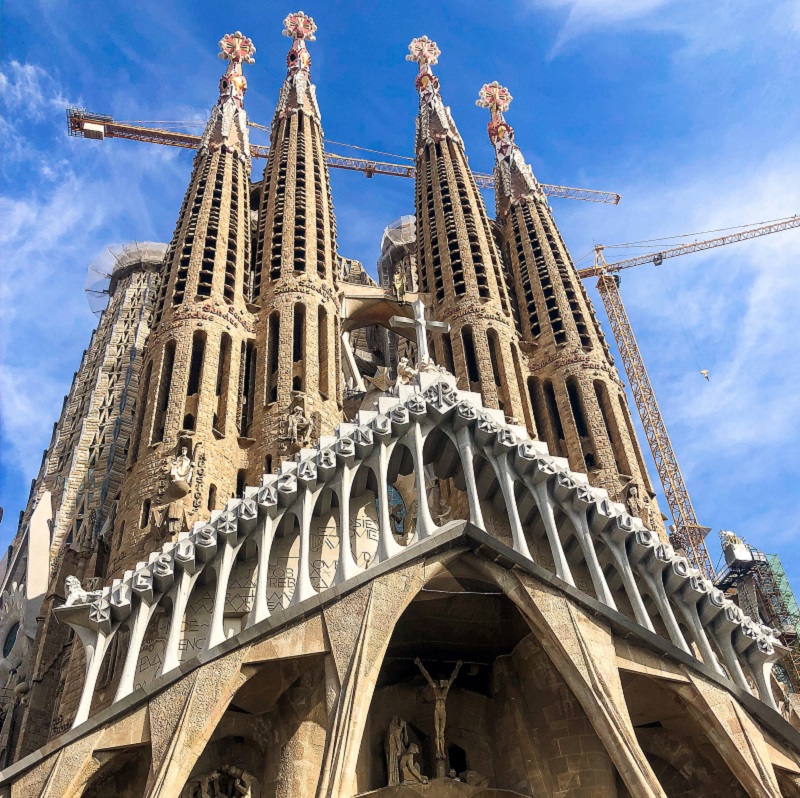
La Sagrada Familia is a magnificent and distinctive church that stands as Barcelona’s landmark and Antoni Gaudí’s world-renowned masterpiece. Gaudí started construction in 1883 and worked on it until his death in 1926, but was nowhere near the completion of the church. La Sagrada Familia is an unfinished church, and despite many years of continued construction after Gaudí’s death, there are still many parts left before the church is completed.
Gaudí did not see much of his intended masterpiece, but he left behind unfinished drawings of the church as a whole, and thereby it is possible to build on from Gaudí’s thoughts and designs. When he worked, he continuously made changes and adjustments to the plans, so in that way Gaudí’s building style was very much alive, which is reflected in his architecture.
The church was planned to be 180 meters high with a central tower. The other twelve towers, representing the number of disciples, Gaudí intended as 100 meters high. The dimensions of the church were supposed to be enormous, and you get a particularly good impression of that if you take the recommended trip up between the towers, which both display grandeur and many splendid details in the design, which is an experience of details everywhere.
The dimensions and Gaudí’s details can of course also be enjoyed in the church interior. There is a museum in the church’s basement, and here you can see a model and sketches of the church’s completion, and that way you can follow the colossal project. At the time of Gaudí’s death, construction was believed to have been between 15 and 25% complete, which of course has increased considerably today. Antoni Gaudí is also buried in a crypt in La Sagrada Familia, so he can still follow the construction in his own way.
The Hospital de Sant Pau is a hospital that was built between 1902 and 1930 by the Catalan modernist architect Lluís Domènech i Montaner, and it has since been included in the UNESCO World Heritage List with the hospital’s many brightly colored buildings and incredible design.
The history of the hospital goes back to 1401, when the institution was founded elsewhere in Barcelona with an association of several hospitals of the time. For many years the institution was called the Hospital de Santa Creu, and the Sant Pau name was added in honor of the banker Pau Gil, who paid for the new buildings in the 1900s that characterize the hospital today.
The site was used as a hospital until 2009, and after a renovation, the Hospital de Sant Pau reopened as a museum and cultural center in 2014. The hospital’s famous buildings consist of a series of pavilions connected by galleries, and everywhere both exterior and interior you can enjoy stunning decorations in what stands as Barcelona’s largest art nouveau building complex.
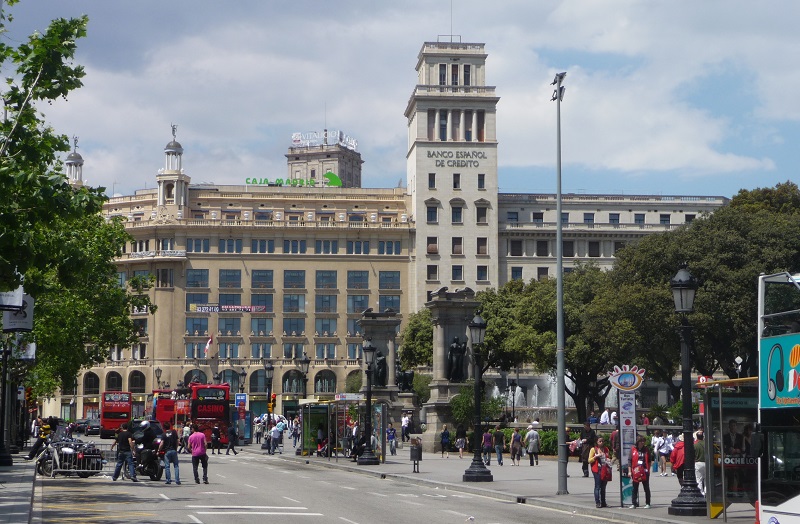
Plaça de Catalunya is a square that is considered the center of Barcelona, and here the old town meets the 19th-century district of Eixample, which was a large-scale expansion of the Catalan capital. You can see several works of art in Plaça de Catalunya, and the open spaces and beautiful fountains always attract many locals and tourists alike.
The predecessor to the current square was laid out in 1859, but the area was not really urbanized until 1902. It was a time when, among other things, there were several theaters in the area around the square. Plaça de Catalunya was also changed in 1929, when there was a world exhibition in the city.
Today, Plaça de Catalunya is a natural starting point for many visitors to the city. Several of Barcelona’s major streets start from here like the famous pedestrian street La Rambla, the Avinguda del Portal de l’Àngel and Passeig de Gràcia, where you can see some of Antoni Gaudí’s architectural masterpieces.
Plaça de Sant Jaume is a centrally located square in Barcelona and also the place where the colony of Barcino, as the ancient Roman city before Barcelona, had its center. It was exactly here that the two most important Roman streets crossed. The importance of the square is emphasized by the fact that the two most important political institutions in the city are located here today.
The Ajuntament is Barcelona’s town hall, and it stands with a beautiful neoclassical facade to the southeast on Plaça de Sant Jaume. The central entrance is flanked by two statues representing Jaume I and the chancellor Joan Fiveller respectively. Opposite the town hall is the Generalitet, the former name of Catalonia’s regional government, which is now housed in the Palau de la Generalitet building, which was originally built from the beginning of the 15th century.
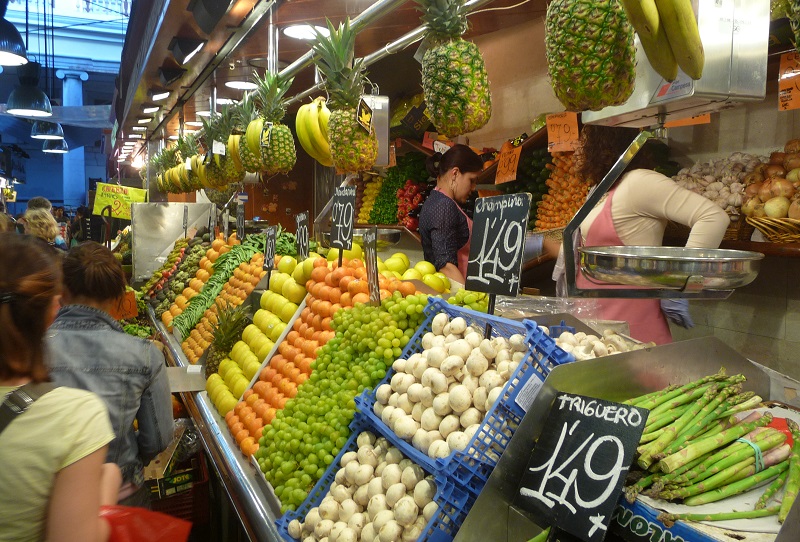
Mercat de la Boqueria is a large market that can be visited behind a series of house facades on La Rambla. A market at this location dates back to the 13th century, where agricultural products from the area were sold here.
At that time, the market was outside the city, and thus it was easy to transport agricultural products here. Today’s market was opened in 1853, and large parts of the market halls were built in 1914.
The Temple d’August was a Roman temple dedicated to the emperor Augustus. The temple was built in the century BC. in the colony of Barcino in the medieval quarter of present-day Barcelona. It measured 35×17 meters in ground plan, and it was built with columns around the inner part of the temple.
The Temple of Augustus was in use until the third century, when it was closed during the time of the Christian emperors. Later, the temple was destroyed, and it languished until the construction of the Center Excursionista de Catalunya in the 1800s, where the preserved ruins were found.
Three columns of the once quite large temple were excavated, and a fourth column, which had been erected in Plaça del Rei, was also moved here. This created the visible ruins of the Temple d’August, which can be seen today in a courtyard in Carrer del Paradís.
Gran Teatre del Liceu is Barcelona’s opera house. The building was constructed 1845-1847 after a private society’s funding. The opera burned down in 1861 to be rebuilt the following year. Again in 1994, a fire destroyed large parts of the theatre, which today has been rebuilt as original as possible.
Some parts of the Gran Teatre del Liceu remain original from the 1800s construction. One example of this is the facade towards La Rambla. There is room for almost 2,300 spectators, and the Liceu is thus one of the largest opera buildings in Europe.
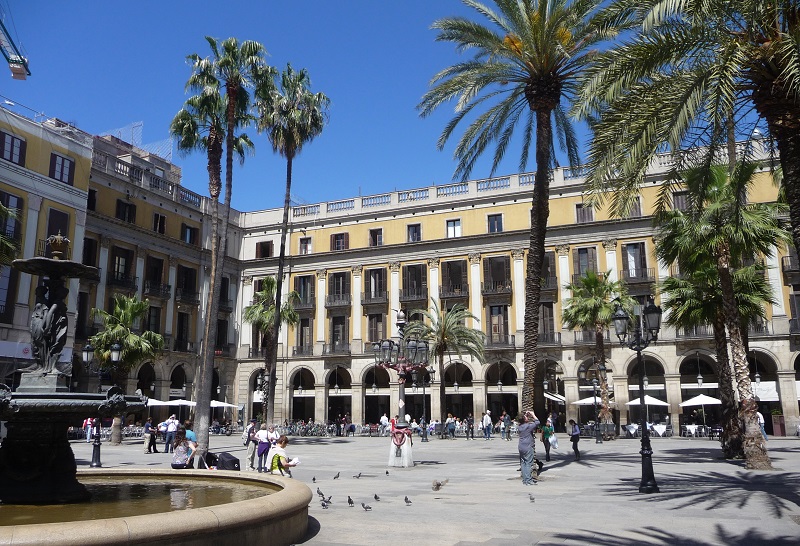
Plaça Reial is one of Barcelona’s most beautiful and harmonious architectural squares. The royal square was created on the site where a monastery burned down in the 1800s, thereby providing the opportunity for new construction.
The buildings around the rectangular square were built in the years 1848-1895. Quite soon after, the square with its benches, slender palm trees, fountains and lampposts from the hand of Antoni Gaudí became a very popular place for the city’s inhabitants. You can see that to this day, and especially in the evening, there is a fantastic atmosphere here.
Palau Güell was world-famous Antoni Gaudí’s first major construction. It was a residence palace that he built in 1886-1888. The house was built for the Güell family, headed by the industrial magnate Eusebi Güell. It was a private residence, and the cathedral-like reception halls in particular are interesting to see.
Gaudí’s works in the city are on UNESCO’s list of world cultural heritage, and although there is inspiration from Gothic and Moorish architectural styles, Gaudí’s style is completely unique. This is clearly seen at the Palau Güell, which was built so that horse-drawn carriages could arrive with guests going to the palace’s main hall, and everywhere they were surrounded by Gaudí’s typical wealth of detail in construction and decoration.
The Museu Marítim is Barcelona’s maritime museum, and since its foundation in 1929, the focus has mainly been on communicating maritime Catalan history. The collection includes interesting ships and a wide range of objects such as model ships, nautical instruments and charts. One of the absolute highlights of the museum is a replica of a 16th-century ship that took part in the naval battle against the Turks at Lapanto in 1572.
Along the street Avenida del Parallel immediately south of the maritime museum, you can also notice a preserved part of Barcelona’s now defunct and decommissioned city walls. They are located in a small green space.
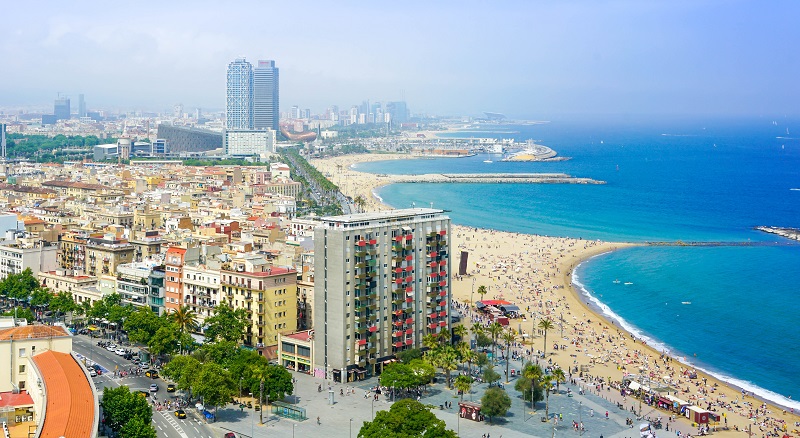
Barceloneta is one of Barcelona’s most atmospheric neighborhoods. It was built in the 18th century at the harbor to rehouse citizens from other parts of the city. After the War of the Spanish Succession in 1714, King Filipe wanted to secure his citizens, and this could be done by building more housing close to the citadel at the current park, Parc de la Ciutadella. The first barracks were replaced by stone houses from 1749.
Many fishermen have always lived in Barceloneta, and today the area is also known for many good seafood restaurants. The narrow streets and wide promenades also act as an invitation to some lovely walks. As does the district’s popular, 1,100-metre-long sandy beach along the Mediterranean Sea.
Parc de la Ciutadella is one of the large urban parks in the center of Barcelona. As the name suggests, there used to be a citadel in this area. The citadel was built by King Philip V after the War of the Spanish Succession at the beginning of the 18th century. It was demolished in 1869, and in 1888 the area became the focal point for the World Exhibition in the city.
After the exhibition, Josep Fontseré created the lovely park that you can enjoy today, based on the remaining parts from the world exhibition. It concerned, for example, some pavilions that form part of the park. Fontseré also created the area’s avenues, the lake with the park’s impressive waterfall sculpture and other things that make the park a good and romantic place for a walk. Among the details of the park is Josep Fontseré’s sculpture of the Lady with Umbrella/La Dama del Paraigua.
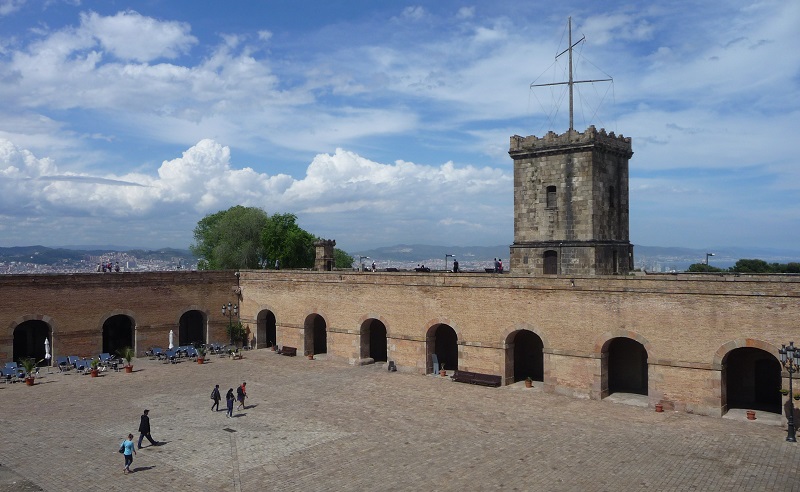
Castell de Montjuïc is the name of the large and interesting castle located on the Montjuïc Hill. The castle’s first structure was built in 1640, while further construction was carried out on Castell de Montjuïc several times in the following century. The Spanish engineer and architect Juan Martin Cermeño designed a new fortification, and therefore the then castle was demolished in 1751.
After the demolition, the current fortifications were built, and the last structures were built between 1779 and 1799. At this time, 120 cannons were also installed on the castle. During the Napoleonic Wars, French troops took Castell de Montjuïc without a fight. It happened because the soldiers at the castle had been instructed not to fire.
You will be rewarded with a wonderful view from Castell de Montjuïc, and it starts already on the trip to the castle if you take the Funicular de Montjuïc cable car, which departs from Barcelona’s port area. You can enjoy a unique panoramic view over Barcelona and the Mediterranean, see the fortress itself and visit the military museum Museu Militar, which Francisco Franco inaugurated in 1963. The museum exhibits a wide range of weapons, uniforms and more.
Font Magica is the name of the magical fountain, which consists of a series of cascades and fountains, which was built for the World Exhibition in 1929. You can still enjoy the site and the installation, where lights accompanied by music create a fantastic atmosphere and experience for visitors.
Font Magica is centrally located in the large landscaped area between Plaça d’Espanya and Palau Nacional, which was the main building of the 1929 Exposition. It was Carles Buïgas who constructed the fountain. He had already designed illuminated fountains from 1922, and in 1929 his work came into focus of the world.
In the place where the Font Magica was built, stood the so-called Four Pillars/Les Quatre Columnes, which can today be seen southeast of the fountain in the axis towards the Palau Nacional. The pillars were erected in 1919 as a symbol of Catalonia’s senyera, which are the four stripes of the Catalan flag. The columns were torn down in 1928 due to the Catalan symbolism, and the current ones were erected in 2010.
Museu Nacional d’Art de Catalunya is one of Barcelona’s leading museums with large collections of Catalan and Spanish art from the last several centuries. The collections from the Middle Ages are particularly interesting, and the museum’s works exceed 250,000 with a wide variety.
There are many highlights among the works you can see. They are, for example, a number of Romanesque works of art that date from the 1000s to the 1200s, and Gothic art from the 1200s to 1400s. Many will probably also take a trip to the Renaissance and Baroque, where artists such as Jacopo Tintoretto, Diego Velázquez, Peter Paul Rubens and Francisco de Goya are represented.
The large museum is located in the palatial building Palau Nacional, which was built for the World Exhibition in Barcelona in 1929 to the design of Eugenio Cendoya and Enric Catà. The Palau Nacional was built with inspiration from the Spanish Renaissance and classicist lines at the top end of a grand staircase.
The Museu Nacional d’Art de Catalunya has been located in the Palau Nacional since 1934, and since then you have been able to enjoy fine works of art and the beautifully decorated building at the same time. There are impressive halls such as the Gran Saló, which were designed for large events, and you can also see fine and brightly colored frescoes in, for example, the dome, which was decorated by Francesc d’Assís Galí.
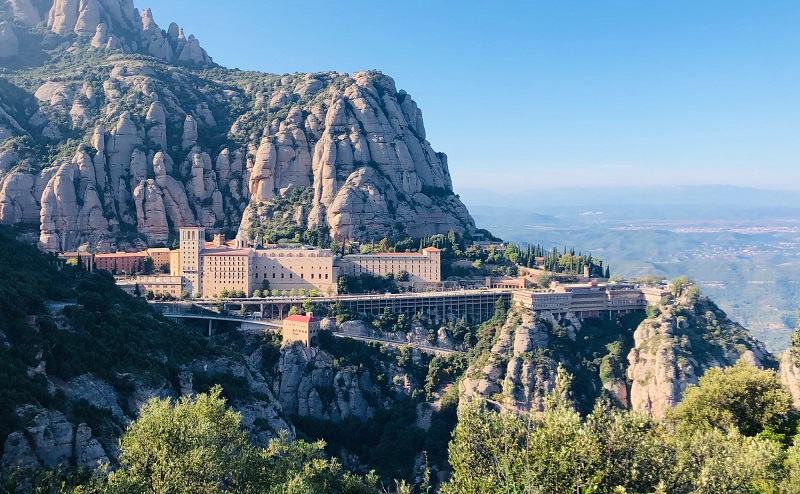
The abbey of Montserrat is one of Spain’s most important religious pilgrimage sites. The monastery and the mountains of the same name are located northwest of Barcelona in a very beautiful area, which is worth seeing in itself. The Montserrat mountains are indeed an exciting sight. They point like soft fingers towards the sky, and in the middle of it all up in the heights lies the large Benedictine abbey, whose history goes back to the year 888. After destruction in 1811 during the Napoleonic Wars, the monastery was partially rebuilt and modernized.
It is said that a shepherd found a statue of the Virgin in a cave in the mountains, and therefore the monastery was built here. The statue was one of the black madonnas, and it was therefore called La Moreneta, the dark one. The Madonna can now be seen in the abbey church, which is the most important Spanish pilgrimage site after Santiago de Compostela.
The actual trip to the Montserrat monastery and the mountain, which is 1,224 meters high, can be taken with the cable car, which can be used both for the monastery and for a trip further up the mountain. The trip up offers good opportunities for some hiking, where you can enjoy many fine viewpoints.
The name of the abbey was by the way also used by Christopher Columbus when, on his second voyage across the Atlantic, he named one of the Antilles Montserrat.
Empúries is a place close to the French border that was founded by the Greeks in 575 BC. with the name Emporion, meaning market. Around 550 BC inhabitants moved from the original location on an island in the river Fluvià to the current location.
The Romans later conquered the city, which for a time had self-government, but was otherwise heavily developed during Roman leadership. As Barcelona and Tarragona gradually grew in importance, Empúries’ role had ended, and first the old Greek quarter was abandoned, and during the later Viking raids the more modern Roman facilities were abandoned as well.
In the city you can see a lot of excavated ruins of the original Greek city called Palaiapolis. The walls surrounding the new city, Neapolis, were built and altered in the 6th to 3rd centuries BC and are relatively well preserved. Ruins of Roman baths and an early Christian basilica also remain. You can also see fine details such as floor mosaics and a well-functioning water supply system.
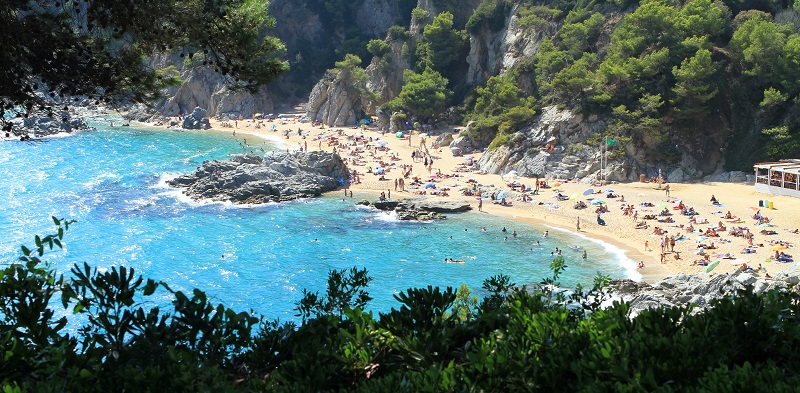
Tossa del Mar north of Blanes was founded by the Romans 2,000 years ago. The city is today a vibrant tourist town, but you can still see many of the city’s interesting historic buildings. The remains of the Roman Ametller villa can be seen in the excavation area, where ceramics, mosaics and various functions such as baths have been found. The objects from the excavation are now in the city museum.
Vila Vella is the old town from the Middle Ages. Vila Vella is surrounded by defensive walls from the 12th century, which were, however, partially changed in 1387. The district housed a Gothic church and up to 80 houses. It is the finest example of the fortified Catalan Mediterranean towns that over time had to defend themselves against enemies on land and against pirates at sea.
The city museum, Museu de Tossa de Mar, is located in Vila Vella’s old governor’s residence, Casa Falguera, which was built in the 14th century. In addition to archaeological finds, it is an art museum with a variety of things on display like a work by Marc Chagall.
The Can Magi lookout tower, called the Moorish Tower, was built in the 16th century as protection against North African pirates. Along the coast these towers were those that could quickly warn the villages of approaching enemies.
If you are in Tossa de Mar, the stretch of coastline between the towns of Tossa de Mar and Sant Feliu de Guixols is worth the whole trip. It is one of the most beautiful along the Costa Brava, the Wild Coast, which really lives up to its name. As a driver, you drive up and down the rugged landscape along the Mediterranean coast with one beautiful view after another.
Figueres is a Spanish city close to the border to France in the Northeastern corner of Spain. There is a lovely atmosphere in Figueres, known for the famous citizen Salvador Dalí. The artist was born here, and the town’s theater from Dalí’s childhood is now set up as a museum for Dalí, who is also buried here.
You can also see Castell de Sant Ferran, Figueres’ mighty fortress, which was ordered to be constructed by King Ferdinand VI after frequent French attacks in the area throughout the 17th century and the first half of the 18th century. Construction work was started in 1753 and lasted until the beginning of the 19th century. The facility is one of the largest of its kind in Europe with 3.2 kilometers long surrounding wall.
Andorra is a mountain state located in the Pyrenees at an altitude of 800-2,900 meters. The state was founded in 805 and soon after it belonged to the city of Urgell. As early as 1176, Andorra became an independent state again, but the country’s written constitution was not drawn up until 1993. Over the centuries, Andorra has been influenced by the two large neighboring countries, France and Spain. Andorra’s area is 468 km², and today around 70,000 inhabitants live in the country.
Most visitors go to the capital, Andorra la Vella, which is not far from the border as everthing else in the small country. The city is well-visited and known for its duty-free shopping, and with its short distances, you can do both sightseeing, shopping and restaurant visits on a walking tour.
Among the sights of Andorra la Vella is the Santa Coloma church from the 8th century. You can also see the Casa de la Vall building, which is the country’s parliament and ministry of justice. The building was constructed in 1580, and it was turned into use as a parliament in 1702. The church Eglisia Sant Esteve was built in the 11th century, and inside you can see paintings from the 13th century.
Andorra also has various museums which are interesting to visit. Most are located in Andorra la Vella like the Andorra Car Museum/Museu Nacional de l’Automòbil or in the town of Ordino, where you can visit Miniature Museum/Museu de la Miniatura and Postal Museum/Museu Postal.
Avenida Diagonal 208
lesglories.com
Avenida Diagonal
diagonalmar.com
Passeig de Gràcia 53/55
bulevardrosa.com
Plaça de Catalunya 14
Avenida Diagonal 617
Avenida Portal d’Àngel 19/21
elcorteingles.es
Passeig de Potosí
lamaquinista.com
Avenida Diagonal 545/557
lilla.com
Moll d’Espanya
maremagnum.es
Rambla de Catalunya, Avenida Diagonal, Passeig de Gracia, Plaza de Catalunya, Calle Portaferissa, Avenida Portal de l’Angel, Calle Boqueriaare
Aquarium of Barcelona
Moll d’Espanya, Port Vell
aquariumbcn.com
Zoo Barcelona
Parc de la Ciutadella
zoobarcelona.com
CosmoCaixa
Teodor Roviralta 47-51
cosmocaixa.com
Parc del Laberint d’Horta
Passeig Castanyers 1
Museu de Ciències Natural
Museu Blau, Forum
bcn.cat/museuciencies
PortAventura
Tarragona, 100 km SW
portaventura.es
Parc d’Atraccions del Tibidabo
Plaça Tibidabo 3-4
tibidabo.es
The first sure signs of habitation are the Thracian-Iberian tribes who settled the present Barcelona area through the 200-100 BC. They established two settlements near the center of the day; Barkeno in what is now the Old Town, and Laie on Montjuïc. In a non-permanent position was also Kallipolis, a Greek village.
Year 218 BC is often considered the real foundation of Barcelona. This year, troops from the Carthage conquered the area during the Second Punic War. It happened under the leadership of Hamilcar Barca. Despite the particularity, however, Barcelona’s name is not meant to come from Barca, but from the Iberian Barkeno.
The following period is little known about Barcelona’s history, but the next time the area became historically interesting was under the increasing influence and conquest of new lands by the Roman Republic.
The power of the Iberian Peninsula was a showdown between Rome and Carthage, and this battle ended Rome victoriously. With the end of the Cantabrian Wars in the year 19 BC the region and thus the settlements on the coast had come under Rome.
Barcelona was a less significant settlement compared to, for example, Terraco and modern-day Zaragoza, and it gained Roman status of colonia named Barcino.
Barcino’s location on the trade route Via Augusta led to rapid economic growth helped by a tax-exempt status. At that time, the city consisted of 12 acres, including two main streets and a central forum.
The population increased rapidly and during the 100’s it reached 5,000. They mainly lived on trade in food and wine from the fertile area.
Germanic tribes increasingly came to looting from the mid-200s, and Barcino’s defense works were therefore greatly expanded. City walls with 78 towers were established and made the city the most fortified in the province.
Despite the attacks and the initial decline of the Roman Empire, some development also occurred in Barcino. The area’s first bishop’s seat was formed in Terraco in 259, and Bishop Preactatus was later mentioned as the first bishop of Barcino. It happened when he attended the Synod of Sardica in 347.
Throughout the 400s, more and more Germanic tribes invaded the Iberian Peninsula, and not least the West Goths created unrest in the area of Barcino during the crumbling West Roman Empire’s slow dissolution, which in 476 was a definitive reality.
With the fall of Rome, Barcino came under the kingdom of the West Goths, who were led from Tolosa; today’s Toulouse. From 507, however, Gesalec moved the capital to Barcino; a status it had to 573, where the West Goths instead established government headquarters in Toledo.
The centuries after the Eastern Roman Empire were marked by various rulers of Barcino, whose name also changed constantly.
The city was, under all leaders, a strong provincial town; not least because of the large defenses built during Roman times.
The 7th century was marked by the Muslim Moors who, from 711, penetrated the Iberian Peninsula and conquered Tarraco in 717. With the fall of Tarraco, Barcino volunteered to avoid destruction during a battle of the city which came under the Moors to was called Barshiluna.
During the Moors’ time in the city, Barshiluna’s Cathedral was converted into a mosque and taxes were imposed on non-Muslims. Otherwise, the time was marked by military focus on defending the city and the area during the troubled time.
In 781, Louis became the pious king of Aquitaine, and as the son of Karl the Great and later co-ruler and king of the Franks, he was a powerful man seeking to expand the kingdom to the southwest.
In 801, Louis conquered Barcelona from the Moors after a long siege. The newly-conquered regions became the southernmost part of the reigning Carolingian kingdom and were established as counties, which was also the case for Barcelona.
The importance and power of the counties increased over the years, and as the Carolingians weakened, the local administration grew stronger.
In 878, Wilfred I became the last count in Barcelona, appointed by the king, and Wilfred had also gathered several counties under him and thus had a larger power base. At the death of the Count in 897, his son, Wilfred II, came to power in Barcelona, and he became the last Count here to swear allegiance to the Carolingians. It increased self-government despite Barcelona formally remaining part of the French Empire until the signing of the Corbeil Treaty between Louis XV of France and Jacob I of Aragon in 1258.
Over the centuries, Barcelona grew due to the city’s strong defense and the increasing power of the local counties, which they used to develop an increasingly large part of the area whose land had been depopulated through wars for hundreds of years.
Barcelona became the leading city in Catalonia at that time, and it was many times larger than Girona to the north. In the expansive city, the economy was good, and it was a major source of dominion; both the counts and the kings of Aragon.
Based on, among other ancient Roman laws, the city evolved continuously, and over time Barcelona became an ever-greater competitor to Madrid’s dominance in the Spanish territory.
In 1469, Barcelona and Madrid “married each other”, as the marriage between Ferdinand II of Aragon and Isabella I of Castile united the two great kings and thus lands. It provided peace and new opportunities, but also breeding ground for further competition between the two main cities.
Spain was, at that time, financially driven by trade in the Mediterranean, and that increased Barcelona’s strategic importance. That changed dramatically with the Spanish colonization of America, which brought new fortunes to the country and to Madrid. Barcelona’s importance was declining, and although trade here continued, the growth of the colonial economy lay.
Madrid, among other things, instructed Barcelona not to trade with the new colonies in America, and in the late 1600s Catalonia declared war on Spain and claimed independence. It happened under the protection of France. The Spanish troops led by the Castile besieged Barcelona and conquered the city.
At the beginning of the 1700s, the Spanish War of Succession ravaged from 1701 to 1714. The war broke out with the extinction of the Spanish Habsburgs with Karl II as the last king, and the parties of the war were mainly Austria, England and the Netherlands against France. Spain was at the heart of the battle, and here Castille stayed with France and Catalonia with Austria.
Both France and Austria had a candidate for a new Spanish king, but when Austria became emperor in 1711, France left with England and the Netherlands at the Peace in Utrecht two years later. It paved the way for the French bourbon with Philip to rule Spain.
For Barcelona, support for Austria had consequences. The Castile, on its way to the takeover, besieged the city in the years 1713-1714, and when Barcelona and the Habsburgs from Austria lost the settlement, Catalonia was ordered to abolish its regional government. At the same time, the citadel of the city was rebuilt so that it could be used for monitoring Barcelona in the future. The Catalan language was banned at the same time, so autonomy was lost in several ways with the war.
From the end of the 18th century a new flourishing started in Barcelona. Industry and trade became economically more important around the Mediterranean, with the Port of Barcelona a major asset.
With the economy, other things and conditions in the city also grew. A new fort was built on Montjuïc, and here French astronomer Pierre François André Méchain was set to make measurements of various distances leading to the production of the first prototype of a meter defined as a 1: 10,000,000 by the distance from the North Pole to the Equator. The final meter stick was produced in platinum and presented in 1799 in Paris.
In the early 1800s, growth in the city continued. Trade with the American colonies became legal again, and after a few years as part of Napoleon’s France of 1812, industrial development in Barcelona as elsewhere in the country really began to take off.
Spain’s first railway was built from Barcelona to Matero, and a major wine production and iron industry was developed, among other things. The city’s population also increased steadily, and over the years a greater expansion of the city’s neighborhoods occurred; eg with Eixample.
Thoughts At the beginning of the 20th century, Catalan self-understanding rose again, and Republican thought was an issue of increasing importance to many local groups. Spain’s leader Primo de Rivera later banned some political entities, and other Catalan institutions such as the FC Barcelona football club were closed.
After the fall of Rivera in 1930, the Catalan nationalists proclaimed Catalonia as an independent state, but this was withdrawn following strong pressure from Madrid. The former regional government was reinstated, but already closed again in 1934 following political attempts to disassociate Catalonia.
Immediately before the impending Spanish civil war, a regional government was again formed. As Franco’s troops in the first period of the Civil War advanced rapidly from southern Spain, Barcelona stood on the side of the republic along with Madrid, which however fell.
The Spanish government fled to Barcelona, and then Franco’s military was out of town. The first aerial bombings started in 1938, and in January 1939 the city fell. Spain was again united under a government in Madrid, Catalan was once again banned as a language, and all street names in the city were now written in Spanish.
Throughout the years until Franco’s death, development within Spain continued, and not least the rising international tourism to many Spanish regions, including the Costa Brava outside Barcelona, triggered an economic recovery.
After Franco’s death in 1975, Catalan politicians in exile returned to Barcelona, and with the accession of King Juan Carlos, autonomy was formed in Catalonia and the regional government was reinstated.
Barcelona joined the rest of Spain in the EC in the 1980s, and it was the starting point for economic and cultural development the city had not previously experienced. An international highlight came in 1992 when the city hosted the Olympic Games. The construction and investment related to the games meant a continuation of the city’s growth period with a strong increase in tourism as one of the effects.
Barcelona is the Catalan capital with millions of inhabitants and a magnificent location on the warm Mediterranean coast. Today, Barcelona is in Spain, but the Catalan history, language and culture clearly make the city and region different to the rest of Spain, and this is interesting to see as a visitor.
Over time, amazing buildings have been built in the various neighborhoods, of which Barri Gotic is the old medieval center with cozy streets, distinguished squares and churches and palaces from ancient times, where rulers of the city were in power. The old town feeling is enjoyed among other places on the beautiful Plaça del Rei and at the cathedral.
The Barcelona travel guide gives you an overview of the sights and activities of the Spanish city. Read about top sights and other sights, and get a tour guide with tour suggestions and detailed descriptions of all the city’s most important churches, monuments, mansions, museums, etc.
Barcelona is waiting for you, and at vamados.com you can also find cheap flights and great deals on hotels for your trip. You just select your travel dates and then you get flight and accommodation suggestions in and around the city.
Click the “Add to Cart” button to purchase the travel guide. After that you will come to the payment, where you enter the purchase and payment information. Upon payment of the travel guide, you will immediately receive a receipt with a link to download your purchase. You can download the travel guide immediately or use the download link in the email later.
When you buy the travel guide to Barcelona you get the book online so you can have it on your phone, tablet or computer – and of course you can choose to print it. Use the maps and tour suggestions and you will have a good and content-rich journey.
Antonio Gaudí • Sagrada Familia • Barceloneta • La Rambla • Montjuîc
Barcelona is the Catalan capital with millions of inhabitants and a magnificent location on the warm Mediterranean coast. Today, Barcelona is in Spain, but the Catalan history, language and culture clearly make the city and region different to the rest of Spain, and this is interesting to see as a visitor.
Over time, amazing buildings have been built in the various neighborhoods, of which Barri Gotic is the old medieval center with cozy streets, distinguished squares and churches and palaces from ancient times, where rulers of the city were in power. The old town feeling is enjoyed among other places on the beautiful Plaça del Rei and at the cathedral.
The Barcelona travel guide gives you an overview of the sights and activities of the Spanish city. Read about top sights and other sights, and get a tour guide with tour suggestions and detailed descriptions of all the city’s most important churches, monuments, mansions, museums, etc.
Barcelona is waiting for you, and at vamados.com you can also find cheap flights and great deals on hotels for your trip. You just select your travel dates and then you get flight and accommodation suggestions in and around the city.
Click the “Add to Cart” button to purchase the travel guide. After that you will come to the payment, where you enter the purchase and payment information. Upon payment of the travel guide, you will immediately receive a receipt with a link to download your purchase. You can download the travel guide immediately or use the download link in the email later.
When you buy the travel guide to Barcelona you get the book online so you can have it on your phone, tablet or computer – and of course you can choose to print it. Use the maps and tour suggestions and you will have a good and content-rich journey.

Plaça de Catalunya is a square that is considered the center of Barcelona, and here the old town meets the 19th-century district of Eixample, which was a large-scale expansion of the Catalan capital. You can see several works of art in Plaça de Catalunya, and the open spaces and beautiful fountains always attract many locals and tourists alike.
The predecessor to the current square was laid out in 1859, but the area was not really urbanized until 1902. It was a time when, among other things, there were several theaters in the area around the square. Plaça de Catalunya was also changed in 1929, when there was a world exhibition in the city.
Today, Plaça de Catalunya is a natural starting point for many visitors to the city. Several of Barcelona’s major streets start from here like the famous pedestrian street La Rambla, the Avinguda del Portal de l’Àngel and Passeig de Gràcia, where you can see some of Antoni Gaudí’s architectural masterpieces.
Plaça de Sant Jaume is a centrally located square in Barcelona and also the place where the colony of Barcino, as the ancient Roman city before Barcelona, had its center. It was exactly here that the two most important Roman streets crossed. The importance of the square is emphasized by the fact that the two most important political institutions in the city are located here today.
The Ajuntament is Barcelona’s town hall, and it stands with a beautiful neoclassical facade to the southeast on Plaça de Sant Jaume. The central entrance is flanked by two statues representing Jaume I and the chancellor Joan Fiveller respectively. Opposite the town hall is the Generalitet, the former name of Catalonia’s regional government, which is now housed in the Palau de la Generalitet building, which was originally built from the beginning of the 15th century.

Mercat de la Boqueria is a large market that can be visited behind a series of house facades on La Rambla. A market at this location dates back to the 13th century, where agricultural products from the area were sold here.
At that time, the market was outside the city, and thus it was easy to transport agricultural products here. Today’s market was opened in 1853, and large parts of the market halls were built in 1914.
The Temple d’August was a Roman temple dedicated to the emperor Augustus. The temple was built in the century BC. in the colony of Barcino in the medieval quarter of present-day Barcelona. It measured 35×17 meters in ground plan, and it was built with columns around the inner part of the temple.
The Temple of Augustus was in use until the third century, when it was closed during the time of the Christian emperors. Later, the temple was destroyed, and it languished until the construction of the Center Excursionista de Catalunya in the 1800s, where the preserved ruins were found.
Three columns of the once quite large temple were excavated, and a fourth column, which had been erected in Plaça del Rei, was also moved here. This created the visible ruins of the Temple d’August, which can be seen today in a courtyard in Carrer del Paradís.
Gran Teatre del Liceu is Barcelona’s opera house. The building was constructed 1845-1847 after a private society’s funding. The opera burned down in 1861 to be rebuilt the following year. Again in 1994, a fire destroyed large parts of the theatre, which today has been rebuilt as original as possible.
Some parts of the Gran Teatre del Liceu remain original from the 1800s construction. One example of this is the facade towards La Rambla. There is room for almost 2,300 spectators, and the Liceu is thus one of the largest opera buildings in Europe.

Plaça Reial is one of Barcelona’s most beautiful and harmonious architectural squares. The royal square was created on the site where a monastery burned down in the 1800s, thereby providing the opportunity for new construction.
The buildings around the rectangular square were built in the years 1848-1895. Quite soon after, the square with its benches, slender palm trees, fountains and lampposts from the hand of Antoni Gaudí became a very popular place for the city’s inhabitants. You can see that to this day, and especially in the evening, there is a fantastic atmosphere here.
Palau Güell was world-famous Antoni Gaudí’s first major construction. It was a residence palace that he built in 1886-1888. The house was built for the Güell family, headed by the industrial magnate Eusebi Güell. It was a private residence, and the cathedral-like reception halls in particular are interesting to see.
Gaudí’s works in the city are on UNESCO’s list of world cultural heritage, and although there is inspiration from Gothic and Moorish architectural styles, Gaudí’s style is completely unique. This is clearly seen at the Palau Güell, which was built so that horse-drawn carriages could arrive with guests going to the palace’s main hall, and everywhere they were surrounded by Gaudí’s typical wealth of detail in construction and decoration.
The Museu Marítim is Barcelona’s maritime museum, and since its foundation in 1929, the focus has mainly been on communicating maritime Catalan history. The collection includes interesting ships and a wide range of objects such as model ships, nautical instruments and charts. One of the absolute highlights of the museum is a replica of a 16th-century ship that took part in the naval battle against the Turks at Lapanto in 1572.
Along the street Avenida del Parallel immediately south of the maritime museum, you can also notice a preserved part of Barcelona’s now defunct and decommissioned city walls. They are located in a small green space.

Barceloneta is one of Barcelona’s most atmospheric neighborhoods. It was built in the 18th century at the harbor to rehouse citizens from other parts of the city. After the War of the Spanish Succession in 1714, King Filipe wanted to secure his citizens, and this could be done by building more housing close to the citadel at the current park, Parc de la Ciutadella. The first barracks were replaced by stone houses from 1749.
Many fishermen have always lived in Barceloneta, and today the area is also known for many good seafood restaurants. The narrow streets and wide promenades also act as an invitation to some lovely walks. As does the district’s popular, 1,100-metre-long sandy beach along the Mediterranean Sea.
Parc de la Ciutadella is one of the large urban parks in the center of Barcelona. As the name suggests, there used to be a citadel in this area. The citadel was built by King Philip V after the War of the Spanish Succession at the beginning of the 18th century. It was demolished in 1869, and in 1888 the area became the focal point for the World Exhibition in the city.
After the exhibition, Josep Fontseré created the lovely park that you can enjoy today, based on the remaining parts from the world exhibition. It concerned, for example, some pavilions that form part of the park. Fontseré also created the area’s avenues, the lake with the park’s impressive waterfall sculpture and other things that make the park a good and romantic place for a walk. Among the details of the park is Josep Fontseré’s sculpture of the Lady with Umbrella/La Dama del Paraigua.

Castell de Montjuïc is the name of the large and interesting castle located on the Montjuïc Hill. The castle’s first structure was built in 1640, while further construction was carried out on Castell de Montjuïc several times in the following century. The Spanish engineer and architect Juan Martin Cermeño designed a new fortification, and therefore the then castle was demolished in 1751.
After the demolition, the current fortifications were built, and the last structures were built between 1779 and 1799. At this time, 120 cannons were also installed on the castle. During the Napoleonic Wars, French troops took Castell de Montjuïc without a fight. It happened because the soldiers at the castle had been instructed not to fire.
You will be rewarded with a wonderful view from Castell de Montjuïc, and it starts already on the trip to the castle if you take the Funicular de Montjuïc cable car, which departs from Barcelona’s port area. You can enjoy a unique panoramic view over Barcelona and the Mediterranean, see the fortress itself and visit the military museum Museu Militar, which Francisco Franco inaugurated in 1963. The museum exhibits a wide range of weapons, uniforms and more.
Font Magica is the name of the magical fountain, which consists of a series of cascades and fountains, which was built for the World Exhibition in 1929. You can still enjoy the site and the installation, where lights accompanied by music create a fantastic atmosphere and experience for visitors.
Font Magica is centrally located in the large landscaped area between Plaça d’Espanya and Palau Nacional, which was the main building of the 1929 Exposition. It was Carles Buïgas who constructed the fountain. He had already designed illuminated fountains from 1922, and in 1929 his work came into focus of the world.
In the place where the Font Magica was built, stood the so-called Four Pillars/Les Quatre Columnes, which can today be seen southeast of the fountain in the axis towards the Palau Nacional. The pillars were erected in 1919 as a symbol of Catalonia’s senyera, which are the four stripes of the Catalan flag. The columns were torn down in 1928 due to the Catalan symbolism, and the current ones were erected in 2010.
Museu Nacional d’Art de Catalunya is one of Barcelona’s leading museums with large collections of Catalan and Spanish art from the last several centuries. The collections from the Middle Ages are particularly interesting, and the museum’s works exceed 250,000 with a wide variety.
There are many highlights among the works you can see. They are, for example, a number of Romanesque works of art that date from the 1000s to the 1200s, and Gothic art from the 1200s to 1400s. Many will probably also take a trip to the Renaissance and Baroque, where artists such as Jacopo Tintoretto, Diego Velázquez, Peter Paul Rubens and Francisco de Goya are represented.
The large museum is located in the palatial building Palau Nacional, which was built for the World Exhibition in Barcelona in 1929 to the design of Eugenio Cendoya and Enric Catà. The Palau Nacional was built with inspiration from the Spanish Renaissance and classicist lines at the top end of a grand staircase.
The Museu Nacional d’Art de Catalunya has been located in the Palau Nacional since 1934, and since then you have been able to enjoy fine works of art and the beautifully decorated building at the same time. There are impressive halls such as the Gran Saló, which were designed for large events, and you can also see fine and brightly colored frescoes in, for example, the dome, which was decorated by Francesc d’Assís Galí.
Similar to Barcelona Travel Guide